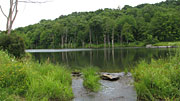- Number 344 |
- August 22, 2011
Consortium to evaluate impacts of shale gas production using hydraulic fracturing

This pond, site of a proposed
Marcellus shale gas well pad,
currently supports an abundant
and diverse fish population.
DOE’s National Energy Technology Laboratory is leading a consortium of eight state and federal agencies evaluating the environmental impacts of shale gas production that uses hydraulic fracturing and drill pads with multiple horizontal wells. This effort was selected by EPA (one of the participating agencies) to be a “prospective case study” for their congressionally mandated investigation of the impact of hydraulic fracturing on sources of drinking water. The Marcellus Test Site differs from the other EPA case study sites (where only impacts to drinking water are being monitored) in that impacts to air quality, terrestrial and aquatic wildlife, soil properties, vegetation, and landscapes (future land use) will also be considered.
The multidisciplinary team will assess changes to water quality, air quality, wildlife and aquatic habitat, agricultural and forestry resources, and land use attributable to the development of the shale gas resource. NETL’s mobile air monitoring station has already been moved downwind of the site to collect four seasons of background (baseline) environmental data (ozone, particulates, organics, and other gases) before well construction begins. Monitoring of environmental parameters will continue through well drilling and completion, and for at least one year of well production. By providing a more complete understanding of the impacts of Marcellus Shale natural gas production on the local and regional environment, NETL can help ensure that development proceeds at a rate that protects the environment while ensuring an adequate domestic supply.
[Linda Morton, 304.285.4543,
Linda.morton@netl.doe.gov]
